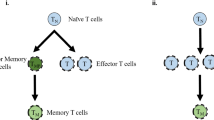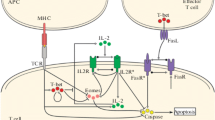Abstract
An artificial immune system model which lacks an explicit pattern recognition mechanism, yet appears to explain immunological memory and immune responses had been proposed[1, 2]. In this study, I asked whether inclusion of a pattern recognition mechanism (antigen-antibody) in the same computer simulation would substantially change the outcomes and thus the explanatory power of the proposed model. Our results suggest that although antigen-antibody interactions can elicit the emergence of an immune response, their relevance is contingent on the previous condition of the system, that is, the starting balance between suppressive and reactive agents (attractor) and its distance from the threshold for an inflammatory response. I conclude that changing the attractor (which maintain the level of reactivity in the background) is more important for the emergence or non-emergence of immune responses than modifying the pattern recognition system.
Access this chapter
Tax calculation will be finalised at checkout
Purchases are for personal use only
Preview
Unable to display preview. Download preview PDF.
Similar content being viewed by others
References
Salazar-Bañuelos, A.: Immune responses: A stochastic model. In: Bentley, P.J., Lee, D., Jung, S. (eds.) ICARIS 2008. LNCS, vol. 5132, pp. 24–35. Springer, Heidelberg (2008)
Stibor, T., Salazar-Bañuelos, A.: On immunological memory as a function of a recursive proliferation process. In: 15th IEEE International Conference on Engineering of Complex Computer Systems, IEEE Press, Oxford (2010)
Delves, P.J., Roitt, I.M.: The immune system. First of two parts. N. Engl. J. Med. 343, 37–49 (2000)
Delves, P.J., Roitt, I.M.: The immune system. Second of two parts. N. Engl. J. Med. 343, 108–117 (2000)
Silverstein, A.M.: A History of Immunology. Academic Press, San Diego (1989)
Davies, J.D., Leong, L.Y., Mellor, A., Cobbold, S.P., Waldmann, H.: T cell suppression in transplantation tolerance through linked recognition. J. Immunol. 156, 3602–3607 (1996)
Charlton, B., Fathman, C.G., Slattery, R.M.: Th1 unresponsiveness can be infectious for unrelated antigens. Immunol. Cell Biol. 76, 173–178 (1998)
Zamora, A., Matejuk, A., Silverman, M., Vandenbark, A.A., Offner, H.: Inhibitory effects of incomplete Freund’s adjuvant on experimental autoimmune encephalomyelitis. Autoimmunity 35, 21–28 (2002)
Calne, R.Y., Sells, R.A., Pena, J.R., Ashby, B.S., Herbertson, B.M., Millard, P.R., Davis, D.R.: Toleragenic effects of porcine liver allografts. Br. J. Surg. 56, 692–693 (1969)
Orosz, C.G.: Immune simulation: applying complexity theory to transplant immunology. Canadian Society of Transplantation, Scientific Meeting, Lake Louise, Canada. Personal Communication (2003)
Greensmith, J., Whitbrook, A., Aickelin, U.: Artificial Immune Systems. In: Gendreau, M., Potvin, J.-Y. (eds.) Handbook of Metaheuristics, 2nd edn., pp. 421–448. Springer, Heidelberg (2010)
Forrest, S., Perelson, A.S., Allen, L., Cherukuri, R.: Self-nonself discrimination in a computer. In: proceedings of the 1994 IEEE Symposium on Research in Security and Privacy, pp. 202–212. IEEE Computer Society Press, Los Alamitos (1994)
Matzinger, P.: Tolerance, danger, and the extended family. Annu. Rev. Immunol. 12, 991–1045 (1994)
Timmis, J.: Artificial immune systems—today and tomorrow. Natural computing: An International Journal 6(1), 1–18 (2007)
Hart, E., Timmis, J.: Application area of AIS: The past, the present and the future. Appl. Soft. Comput. 8(1), 191–201 (2008)
Orosz, C.S., Forrest, S., Hoffmeyr, S., Cohen, I.R., Segel, L.A.: How complexity helps to shape alloimmunity. Graft 4, 365–382 (2001)
Salazar-Bañuelos, A.: Non-deterministic explanation of immune responses: A computer model. In: Andrews, P.S., Timmis, J., Owens, N.D.L., Aickelin, U., Hart, E., Hone, A., Tyrrell, A.M. (eds.) ICARIS 2009. LNCS, vol. 5666, pp. 7–10. Springer, Heidelberg (2009)
Burnet, F.M.: A modification of Jerne’s theory of antibody production using the concept of clonal selection. Aust. J. Sci. 20, 67–69 (1957)
Von Boehmer, H., Teh, H.S., Kisielow, P.: The thymus selects the useful, neglects the useless and destroys the harmful. Immunol. Today 10, 57–61 (1989)
Alfred, I.T.: The Immune Self, Theory or metaphor? Cambridge University Press, Cambridge (1994)
Sakaguchi, S.: Regulatory T Cells: key controllers of immunologic self-tolerance. Cell 101, 455–458 (2000)
Coutinho, A.: The Le Douarin phenomenon: a shift in the paradigm of developmental self-tolerance. Int. J. Dev. Biol. 49, 131–136 (2005)
Salaun, J., Simmenauer, N., Belo, P., Coutinho, A., Le Doarin, N.M.: Grafts of supplementary thymuses injected with allogeneic pancreatic islets protect nonobese diabetic mice against diabetes. Proc. Natl. Acad. Sci. U.S.A. 99, 874–877 (2002)
Salaun, J., Corbel, C., Le Douarin, N.M.: Regulatory T cells in the establishment and maintenance of self-tolerance: role of the thymic epithelium. Int. J. Dev. Biol. 49, 137–142 (2005)
Carneiro-Sampaio, M., Coutinho, A.: Tolerance and autoimmunity: lessons at the bedside of primary immunodeficiencies. Adv. Immunol. 95, 51–82 (2007)
Quintana, F.J., Cohen, I.R.: Regulatory T cells and immune computation. Eur. J. Immunol. 38, 903–907 (2008)
Cui, Z., Zhao, M.H., Segelmark, M., Hellmark, T.: Natural autoantibods to myeloperoxidase, proteinase 2, and the glomerular basement membrane are present in normal individuals. Kidney Int. (2010)
Levin, E.C., Acharya, N.K., Han, M., Zavareh, S., Sedeyn, J.C., Venkataraman, V., Nagele, R.G.: Brain-reactive autoantibodies are nearly ubiquitous in human sera and may be linked to pathology in the context of blood-brain barrier breakdown. Bran. Res. (2010)
Marin, G.G., Cardiel, M.H., Cornejo, H., Viveros, M.E.: Prevalence of antinuclear antibodies in 3 groups of healthy individuals: blood donors, hospital personnel, and relatives of patients with autoimmune diseases. J. Clin. Rheumatol. 15, 325–329 (2009)
Trendelenburg, M.: Autoanibodies-physiological phenomenon or manifestation of disease. Praxis (Bern 1994) 96, 379–382 (2007)
Nilsson, B.O., Skogh, T., Ernerudh, J., Johansson, B., Lofgren, S., Wikby, A., Dahle, C.: Antinuclear antibodies in the oldest-old women and men. J. Autoimmun. 27, 281–288 (2006)
McKenna, R.M., Takemoto, S.K., Terasaki, P.I.: Anti-HLA antibodies after solid organ transplantation. Transplantation 69, 319–326 (2000)
Author information
Authors and Affiliations
Editor information
Editors and Affiliations
Rights and permissions
Copyright information
© 2011 Springer-Verlag Berlin Heidelberg
About this paper
Cite this paper
Salazar-Bañuelos, A. (2011). Relevance of Pattern Recognition in a Non-deterministic Model of Immune Responses. In: Liò, P., Nicosia, G., Stibor, T. (eds) Artificial Immune Systems. ICARIS 2011. Lecture Notes in Computer Science, vol 6825. Springer, Berlin, Heidelberg. https://doi.org/10.1007/978-3-642-22371-6_12
Download citation
DOI: https://doi.org/10.1007/978-3-642-22371-6_12
Publisher Name: Springer, Berlin, Heidelberg
Print ISBN: 978-3-642-22370-9
Online ISBN: 978-3-642-22371-6
eBook Packages: Computer ScienceComputer Science (R0)




